Samantha Lee
November 16, 2016
Photo credit – Samantha Lee
- Samantha Lee is a contributing restaurant reviewer for Whisk and Quill. We are pleased to share her experiences dining in the trendiest local Asian restaurants.
Walking from the U Street Metro Station to Izakaya Seki, you may notice a prominent chōchin beside a two-story brick townhouse’s front door. Made of shōjigami (a special type of paper), this traditional red lantern, constructed with a wooden or bamboo frame, is lit by a small candle and hung from bamboo sticks. In Japan these lanterns are commonly found outside shrines and small bars where the color red is said to bring good luck to the business. The term izakaya denotes a type of Japanese drinking establishment people visit after work, most notably for sake.
Before opening this restaurant, Chef Hiroshi Seki spent more than two decades as chef/owner of Seki, a successful sushi restaurant in St. Louis, MO. More recently he left the St. Louis area, to be closer to his daughter, Cizuka. Once here, the father-daughter team laid plans to for their partnership. While Cizuka didn’t attend culinary school, she did gain valuable experience working one week of 16-hour shifts at Den, a two Michelin-starred restaurant in Tokyo.
In August 2012, they opened Izakaya Seki, serving authentic Japanese comfort food and drinks. On the first level the Sushi Chef’s counter accommodates ten guests while on the second level, a dining room with small tables seats up 26 in a more intimate setting. Chef’s counter seating is hard to come by and it’s a great place to sit if you like to watch how your food is prepared. However, I prefer the upstairs dining room, which is quieter and has a more relaxing atmosphere.
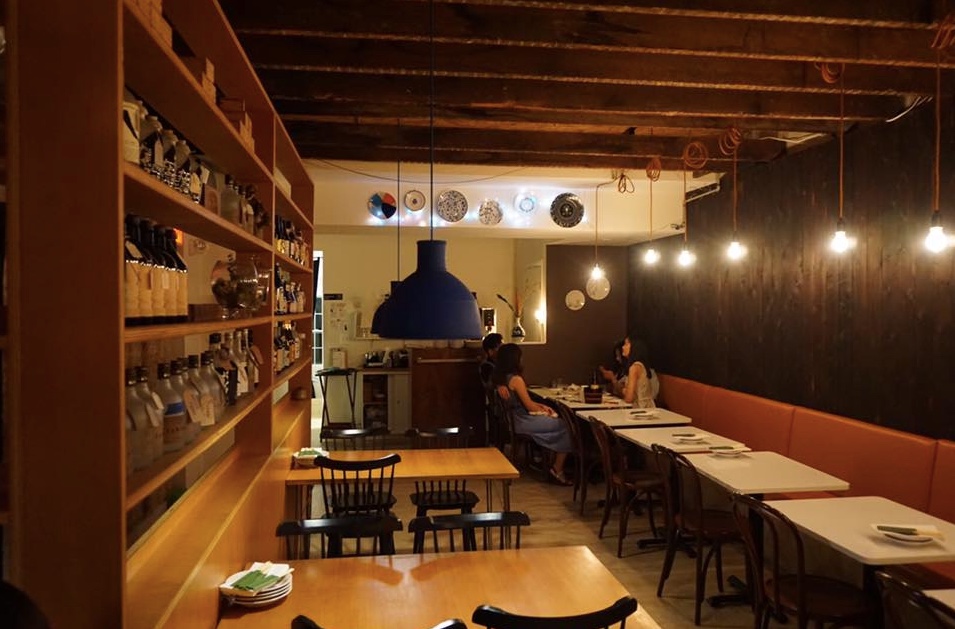
The simple first floor décor features wall-hung vases and a few paintings. Along the stairway is a denim quilt and upstairs, among shelves of assorted sake bottles, are a pair of smaller paintings – one of a bear fishing and another of a bear eating.
The subject of the two paintings by Japanese contemporary artist Ryota Unno derive from Japanese folklore of the upland regions. One is of a polar bear and the other is an Asian black bear, also known as a “moon bear”, or white-chested bear, because of its crescent moon-shaped marking. In Japanese literature, the Asian black bear is associated with the mountain spirit.
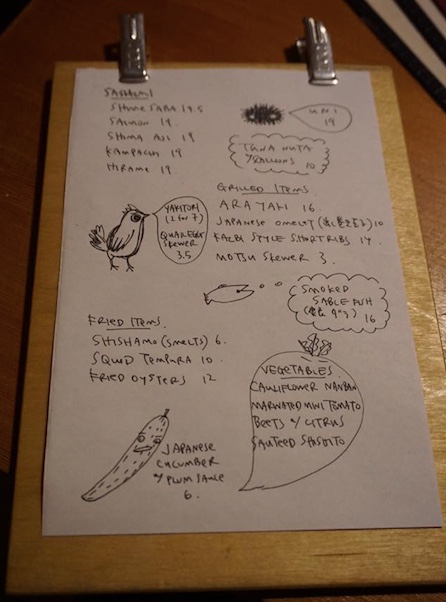
Check out the drinks menu to find an extensive array of choices including sake, Japanese whiskeys, wines, Japanese craft beers, shochu, and cocktails. Shochu is a Japanese distilled alcoholic beverage made from rice, barley, sweet potatoes, buckwheat or brown sugar. It can also be made from chestnuts, sesame seeds, potatoes or carrots though those are less common.
You’ll note the food menu is separated into categories: ‘Raw’, ‘Grilled’, ‘Fried’, ‘Noodles’, ‘Rice’, and ‘Specials’. Our group consisted of five adults who shared many dishes from each menu.
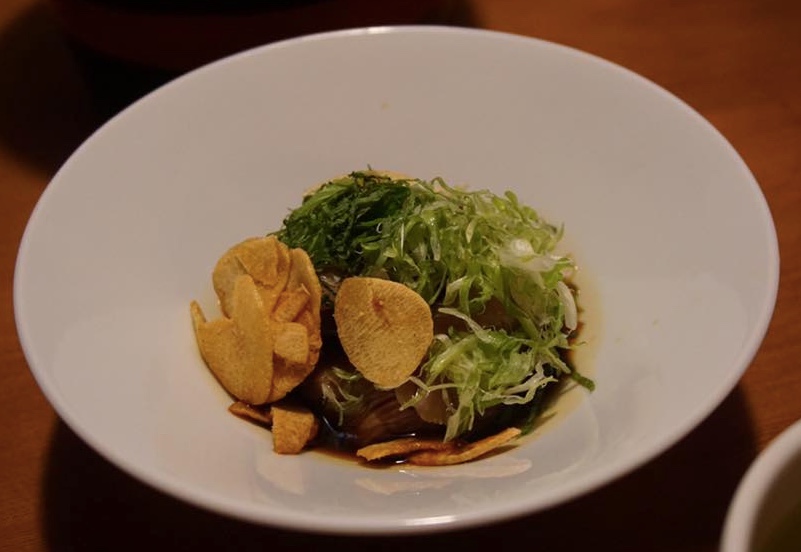
Tuna Tataki
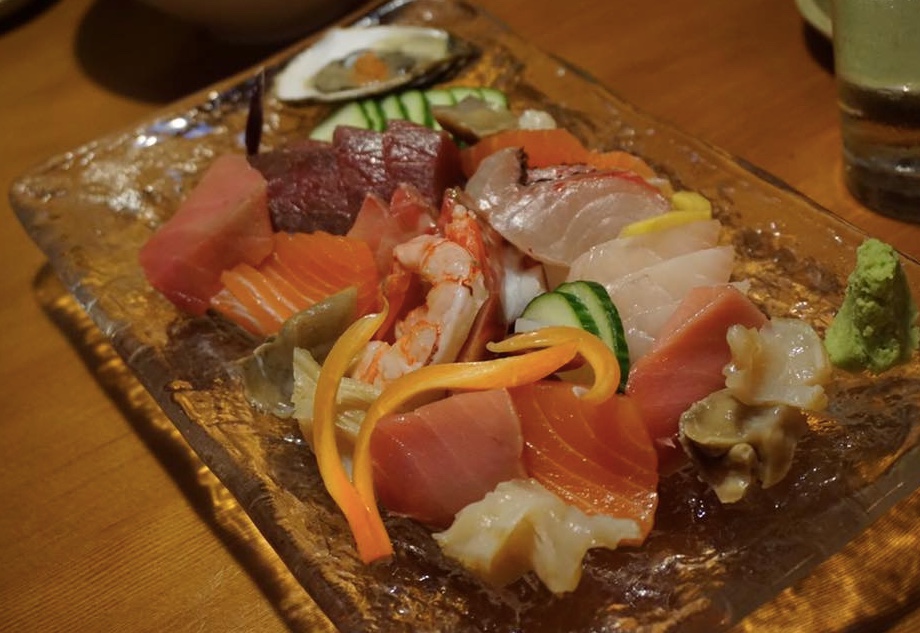
Omakase Sashimi
From the ‘Raw’ category, we chose the Tuna Tataki and Omakase Sashimi. The Tuna Tataki consisted of seared yellowfin tuna with ponzu sauce, topped with scallions and garlic chips. The Omakase Sashimi was a generous chef’s selection of assorted fish (including salmon, tuna, red snapper) and other kinds of seafood (including clam, octopus, squid, oyster, and shrimp). The plate was garnished with cucumber slices and lemon curls, and served with wasabi and pickled ginger. I enjoyed the freshness and wide variety of the sashimi.
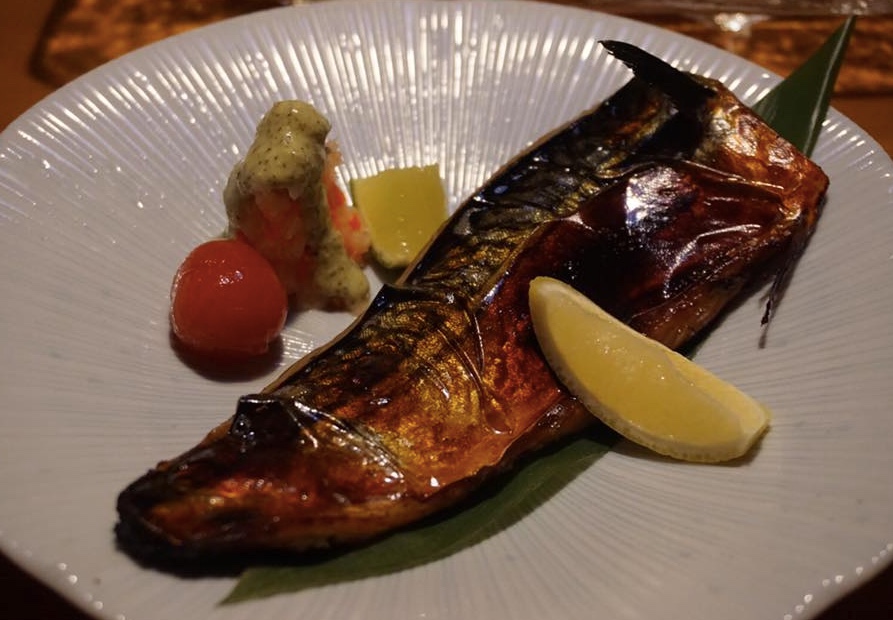
Saba Marinated in Sake and Miso
From the ‘Grilled’ category, we selected the Saba Marinated in Sake and Miso. Saba is a fancy name for a Spanish Mackerel and is usually prepared with five ingredients – mackerel, miso, sake, mirin (sweet rice vinegar), and sea salt. In Asian cultures, a salty miso marinade is used to preserve foods. The caramel-colored mackerel is served with head intact on a banana leaf and accompanied by grape tomato, wasabi cream sauce over mountain of grated ginger and wedges of lime and lemon.
From the ‘Fried’ category, we opted for Vegetable Tempura and Baby Octopus. The vegetable tempura consists of seasonal vegetables – ours had pumpkin, eggplant, zucchini, onion, and purple sweet potato – battered in tempura batter. Its accompanying dipping sauce is made from a blend of mirin, soy sauce, and dashi stock. The octopus dish is five pieces of baby octopus breaded and deep fried, served with lemon wedge and sweet, but mildly spicy, shishito peppers.
From the ‘Meats’ category, we enjoyed the Kakuni, described as “slow braised silk pork’ it arrives as lean slices of pork belly slow-braised in a sweet soy sauce and garnished with grated ginger and handful of chopped scallions.
In the ‘Rice/Noodles’ category, Chahan is a savory blend of fried rice, shallots, shiso, soy, dashi broth, garlic, and butter with garlic chips and shiso leaf. Personally, I didn’t enjoy it as much. I found it to be too bitter. But my fellow dining partners loved it.
On the evening’s ‘Specials’ menu was Tamagoyaki, thin layers of pan-fried eggs rolled into a log and placed in rectangular tamagoyaki pan. It was served warm and you could tell each layer was seasoned. I was surprised that it wasn’t sweet like the tamago sushi, but rather natural tasting. Despite the eggy taste, it was one of my favorites.
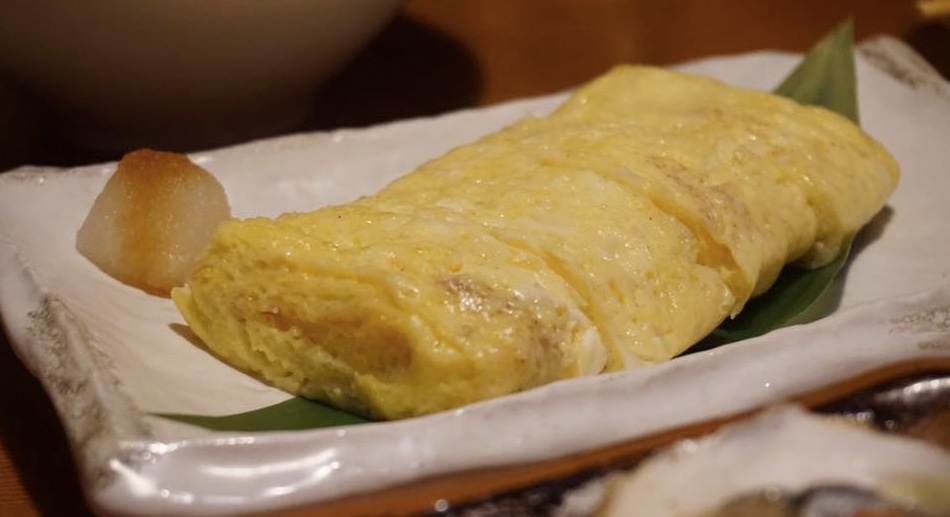
Warm egg omelet
Instead of picking one of the desserts, we decided to try all the desserts on the menu – Purin with Sesame Sauce, Ginger Ice Cream and Mochi Rice Cakes with Red Beans. These desserts are small and not the best for sharing.
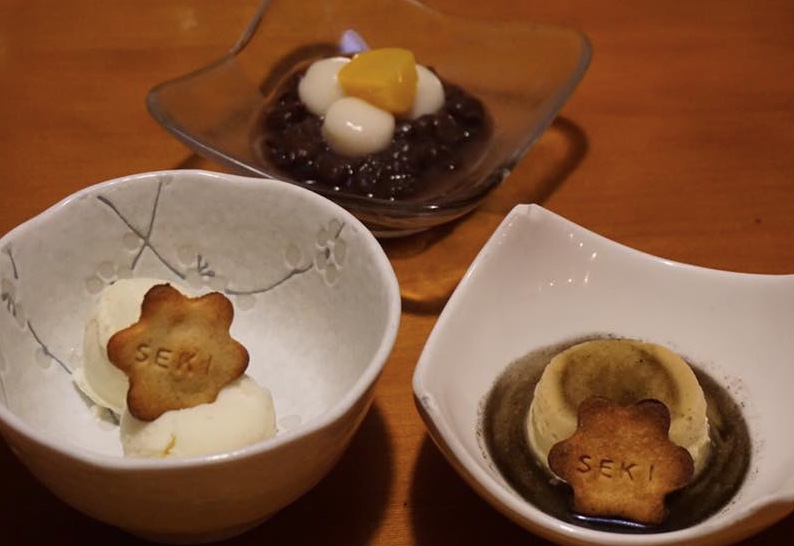
Trio of desserts
Purin is a cold custard pudding dessert similar to a flan but much silkier, creamier and firmer. It is made with four simple ingredients – milk, eggs, sugar and vanilla. It is shaped like a plumeria – a five-petaled flower symbolic of grace, delicacy and beauty. It is served in a sheer black sesame sauce and garnished with a slightly burnt plumeria-shaped butter cookie embossed with ‘SEKI’.
Ginger Ice Cream is two melon ball-sized scoops of homemade ginger ice cream garnished with the same cookie.
The Mochi Rice Cakes with Red Beans are made with red bean paste and topped with three powder-dusted mochi rice cakes garnished with sweet chestnut pickle. These rice cakes are made of sweet white flour, sugar and water and shaped like golf balls. The texture is soft and chewy at the same time. The sweet chestnut pickle is made of cinnamon bark, caster sugar, chestnuts and water. I enjoyed this dessert the most because it was very authentic and it brought back memories of my recent visit to Japan.
Overall, I liked The tuna tataki, omakase sashimi, saba, tamagoyaki, and mochi rice cakes with red beans, though you may want to try their cold buckwheat noodles, aka soba, which are hard to find in our area.
Izakaya Seki is the perfect venue for parties of all sizes, whether couples, friends or family. If you find yourself in the Cardoza neighborhood craving quality Japanese cuisine, I highly recommend you go. I know I’ll be back soon.
Izakaya Seki, 1117 V Street NW, Washington, DC 20001. 202 588.5841 www.sekidc.com